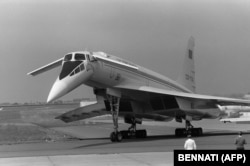Its maiden flight lasted for a little over half an hour and failed to reach the Mach speed it was engineered for. But when the Tupolev Tu-144 successfully took to the air on December 31, 1968, it gave the Soviet Union bragging rights as the first to put a supersonic airliner into flight, beating its Western competitor by two months.
The sky appeared to be limit for the Concordski, the moniker given to the Soviet world-beater in a nod to its similarities to its luxurious rival, the Concorde.
In a costly Cold War battle for technological supremacy that played out alongside the space race, the Tu-144 bested its British-French rival again in June 1969, when it reached supersonic speeds.
The two aircraft were similar in appearance. Each featured a variant of the delta wing, and a downward sloping needle nose that drew comparisons to a swan's neck. The most striking visual difference was the pair of canards, or winglets, behind the cockpit of the Soviet aircraft. Under their heat-resistant skins, designed to withstand airspeeds above Mach 2, the differences were more evident.
The Tupolev was slightly longer (65.7 meters vs. 61.7) and heavier and, once a suitable and more powerful engine configuration was settled upon, could reach a higher maximum speed. The Concorde boasted more advanced engine and braking systems, and state-of-the-art air-intake and wing-shaping systems that were controlled by computer.
The Soviet plane was designed to carry 140 passengers, whereas the Concorde was fitted for 92 to 120 passengers. The Tu-144's crew of three could rely on one feature lacking in the Concorde -- ejection seats (not available for passengers).
The Western world got its first glimpse of the Soviet supersonic jet at the Paris Air Show in 1971, feeding anticipation over which plane would win the next leg of the race -- being the first to carry passengers.
But two years later at the same show, the Tu-144 was the center of attention for all the wrong reasons. The Concorde had just finished its 30-minute display on June 3, 1973, when the Tu-144 took to the skies to show off its capabilities in half the allotted time. After pulling off a series of twists and turns, the Soviet airliner crashed, killing all six crew members and eight people on the ground.
Some speculated that the plane had crashed to avoid a collision with a French Mirage jet, which was alleged to have flown too close in an attempt to photograph the Tu-144's unique canards.
The 1973 tragedy at the French air show signaled the beginning of the end for the Tu-144. It pushed back the Soviet program by four years, allowing the Concorde to leapfrog its Soviet competitor when it became the first to begin scheduled commercial passenger flights in 1976.
The Tu-144 did start transporting passengers in 1977, but praise was scant and complaints many, including cramped space and ear-splitting engine noise. The Tu-144 was also prone to mechanical malfunctions.
The Tu-144 flew only 55 roundtrip flights on its lone commercial route, between Moscow and Alma Ata (now Almaty), which was reportedly chosen by Aeroflot because it passed over largely underpopulated areas. The service proved unpopular and Aeroflot canceled it six months later.
Aeroflot officially terminated its ties with the Tu-144 after a modified model crashed on a test flight near Moscow in June 1978. In 1982, production of the Tu-144 came to an end, although the airliner remained in service as a cargo plane until 1983. All in all, the fleet of 16 aircraft completed a total of 102 commercial flights.
The Concorde enjoyed a more celebrated career ferrying the rich and famous around the world, including its popular New York-to-London route that could be completed in less than three hours.
On July 25, 2000, Concorde Air France Flight 4590 crashed on takeoff, killing 100 passengers and nine crew members. It proved too much to overcome, and the seven supersonic airliners each operated by Air France and British Airways were retired for good in 2003.


